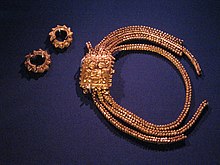Ban Zu
Ban Zu or Banzu (Chinese: 班卒; pinyin: Bānzú; Wade–Giles: Pan-tsu; Malay: Pancur) was a port settlement believed to have thrived in Singapore during the 14th century.It was mentioned by the Chinese traveller Wang Dayuan in his work Daoyi Zhilüe together with Long Ya Men as the two settlements that made up Temasek.[2] Historical information on Ban Zu comes from the Yuan dynasty work Daoyi Zhilüe written by Wang Dayuan.Stamford Raffles mentioned the lines of the old city and its defences, and the British Resident John Crawfurd wrote about the ruins in some details.[11] Crawfurd also noted the remains of buildings, some of brick foundation, on the west and northern side of Fort Canning Hill.[12] Crawfurd also mentioned ancient fruit trees cultivated in the gardens, and found pottery fragments and Chinese coins, the earliest of which were dated to the 10th-century Song dynasty.[15][16] Archaeological excavations were conducted on Fort Canning by John Miksic in 1984, later expanded to nearby area bounded by the hill, the banks of the Singapore River and the sea, such as the Parliament House Complex, Empress Place and other locations.

Singapore RiverEarly history of SingaporeTopynymyTemasekLong Ya MenMalay AnnalsKingdom of SingapuraSang Nila UtamaParameswaraBadangArchaeology in SingaporeSingapore StoneFort Canning HillChinesepinyinWade–GilesSingaporeWang DayuanDaoyi ZhilüeSiameseMajapahitChinese transcriptionFansurSingapuraPaul Wheatleyhornbill casqueslakawoodsinghamukhaStamford RafflesResidentJohn CrawfurdStamford RoadIskandar ShahSong dynastyFort Canning reservoirJapanese occupation of SingaporeFort CanningJohn MiksicParliament House ComplexEmpress PlaceHistory of SingaporeUniversity of Malaya PressJohn N. Miksic